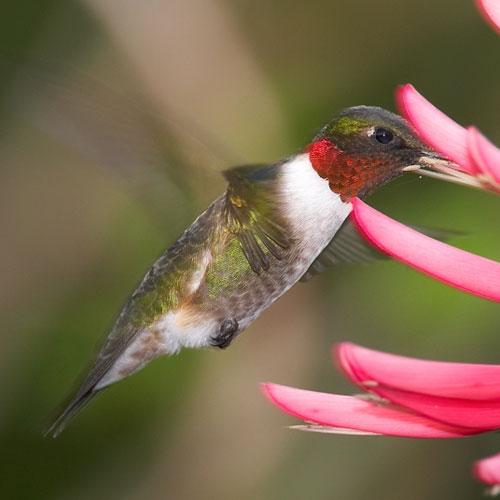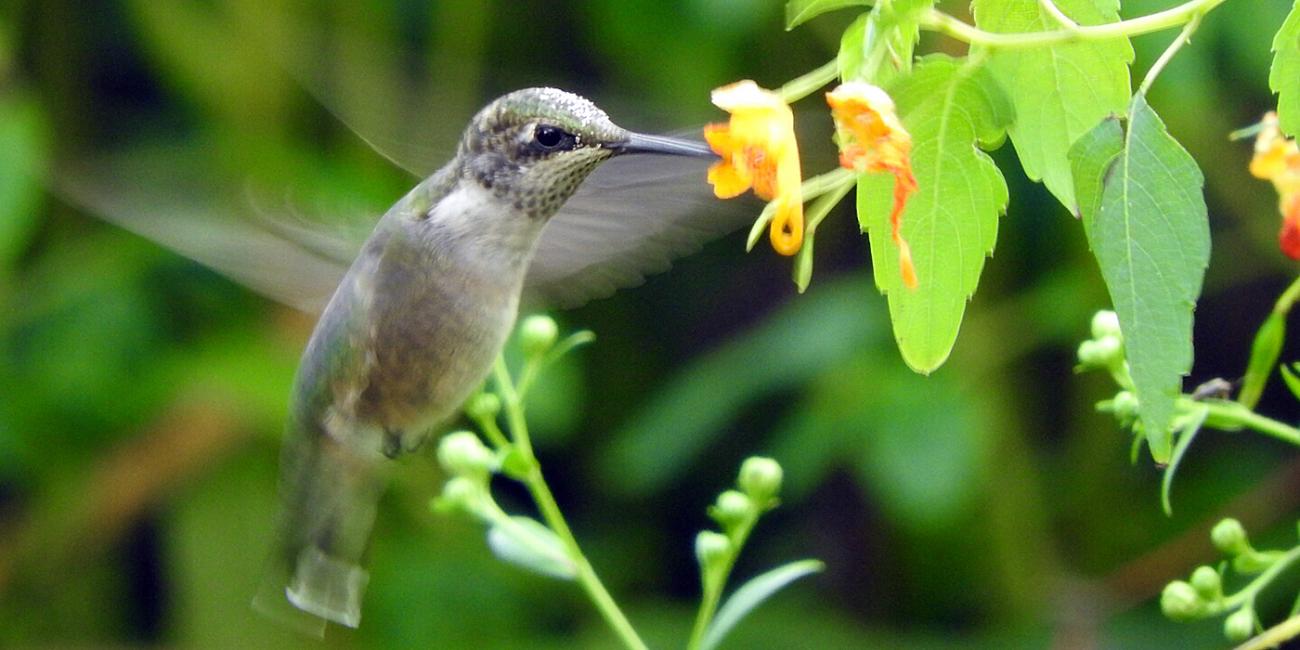Flower Specialist
Ruby-throated Hummingbird
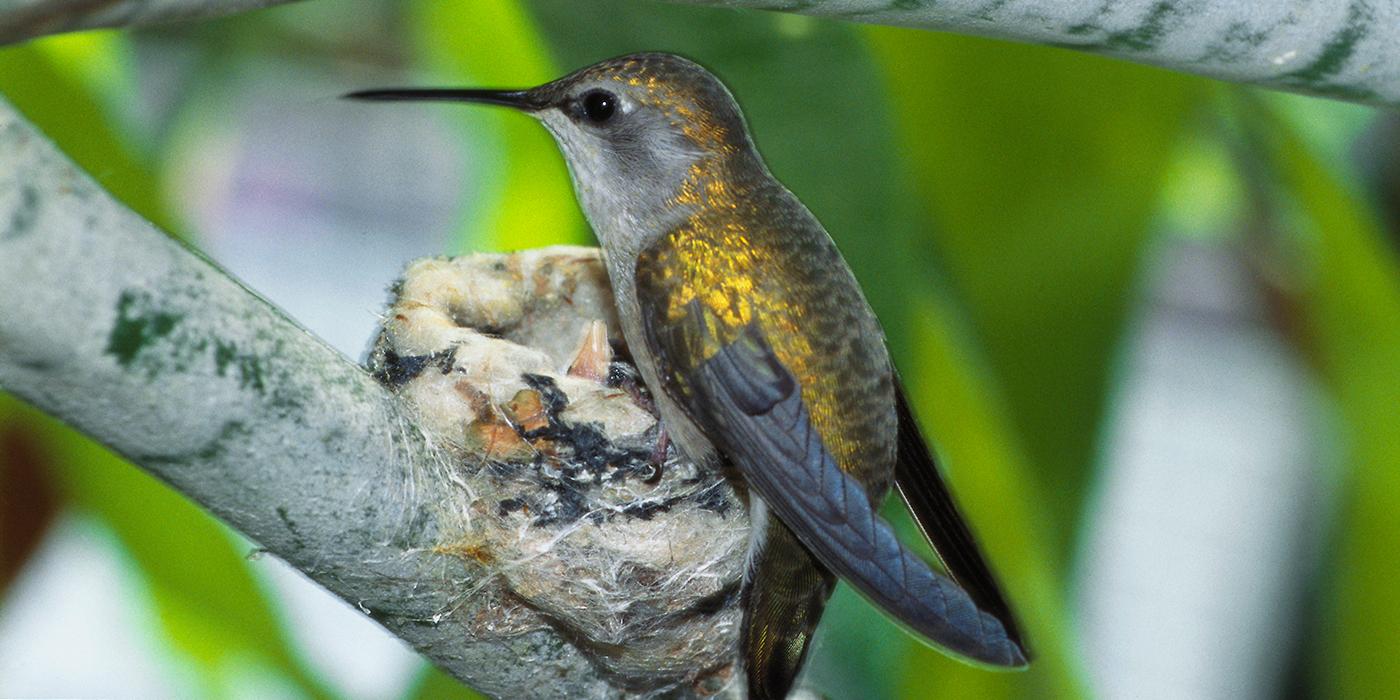
Watch a hummingbird, and you will learn quickly what it likes to eat: nectar. The ruby-throated hummingbird, like all hummingbirds, is a nectar specialist. Its long bill and special tongue are designed to fit into flowers and lap up nectar. We know that hummingbirds are flower specialists, but what about the other perspective: which flowers are hummingbird specialists?
Flowers, at least the colorful ones, are there to attract pollinators to the nectar they provide. They offer nectar to pollinators—bees, birds, bats, beetles, and butterflies—who pick up a little pollen on their bodies as they help themselves to some nectar. The pollinators in turn rub a little of that pollen off on the next flower they visit. The plant then gets to reproduce and the flower visitor gets a meal in exchange for its services.
Many flowers are general in their approach, accommodating a variety of pollinators. But just as some birds are specialized to eat certain things, some flowers are specialized to have certain animals visit them. Flower specialization can be extreme; in some cases, the design of the flower only allows one species of animal to pollinate it.
One famous example is an orchid in Madagascar (discovered by Charles Darwin) that holds its nectar in the bottom of a 11.5-inch narrow tube. Only one animal in the whole, biologically diverse rainforest can get to that nectar: a sphinx moth species that has an 11.5-inch proboscis!
Now, how do we figure out which flowers are specialized for hummingbird pollination—and more specifically, for the ruby-throated hummingbird? As a first step, we'll limit the search area to the eastern U.S. and Canada where the ruby-throat is a common summer breeding bird. It is the only hummingbird that comes to this region. (The vast majority of hummingbird species are resident in tropical America. Only 17 of the 320 species of hummingbirds migrate to North America to breed, and only the ruby-throat comes to the East.) So any hummingbird-specialist flowers in the East are really ruby-throat specialists.
A few patterns have emerged from research on hummingbirds and their flower preferences. Hummingbirds have a strong preference for flowers with nectar that is composed of sucrose, rather than fructose or glucose, the other common components of flower nectar.
Also, hummingbirds are attracted to certain colors—most often red, but also orange and yellow. Flowers that attract hummingbirds often have a tubular shape, to accommodate long bills and tongues.
Since hummingbirds use sight to find flowers rather than scent, a flower specializing in hummingbird pollination wouldn't have much odor. So, if you have a purple flower with fructose-based nectar, that smells wonderful, it probably isn't a expecting a hummingbird to pollinate it.
A few flowering plants in the eastern United States meet all of a hummingbird's requirements. But unlike the orchid and moth in Madagascar, no plants in eastern North America are completely dependent on hummingbirds for pollination. Most would still get pollinated by something else if hummingbirds were to disappear. But it may be that hummingbirds do the best job for some flowers.
One bit of evidence for this comes from research on hummingbirds and jewelweed (Impatiens capensis), an annual that grows in moist, shady places. It has an orange or yellow flower that dangles on a wobbly stem with nectar stored at the end of a tube.
A study found that even though bumblebees also visit jewelweed, hummingbirds do a far better job at pollinating it. This is because when a hummingbird visits the flower, it causes the flower to wobble and this wobbling rubs lots of pollen on the bird's face. When the bee visits jewelweed, its movements are more delicate. The flower stays still and the bee leaves with less pollen to take to the next flower.
For a gardener who wants to attract hummingbirds, it's not that important to know whether a flower evolved specifically to accommodate hummingbirds. For this purpose, we just need to know what flowers are attractive to hummers. They love jewelweed, of course.
But there are a few other standouts as well. Luckily these other plants have a range of blooming times that ensures that flowers are available for ruby-throated hummingbirds throughout the time they are in the United States.

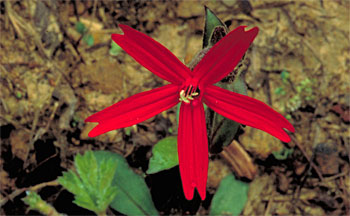
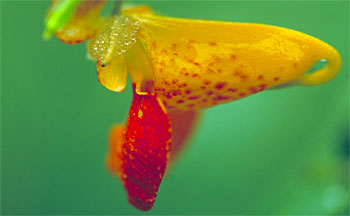
From top to bottom: Cardinal Flower, Fire Pink, and Jewelweed. © Dr. Thomas Barnes/USFWS
- In spring, when hummers are heading north, arriving from their wintering areas in Mexico and Central America, two hummingbird favorites are blooming: red buckeye (a shrub), and fire pink (a wildflower). Both have bright red flowers.
- In early to mid-summer, when hummingbirds have established territories and are busy tending to nests and young families, trumpet vine comes into bloom. This woody vine has large orange tubular flowers that seem to be tailor-made for a hummingbird. Look at Audubon's painting of a ruby-throated hummingbird, and notice that he included trumpet vine in the picture.
- In the latter part of the summer, just in time for hungry young hummingbirds barely out of the nest to get their first taste of nectar, jewelweed comes into bloom. (As nestlings, much of their diet is insects, because young birds need lots of protein.)
- In late August, when hummers are beginning to journey back to the tropics, cardinal flower, a bright-red lobelia, becomes available on shady stream banks.
All of these plants are widespread throughout large parts of the ruby throat's range and all do well in backyard gardens. Many online and print resources are available to help you cultivate a hummingbird garden.
I know one suburban backyard owner with a great hummingbird garden who didn't do anything at all except let a little piece of the yard go. It didn't take any special care, planting, or gardening to create a mini-refuge. The garden started out as part of a typical neatly mowed grass yard. But then a few small areas by the back fence were left alone. There wasn't much to see at first, just rangy overgrown grass.
In the fall, they piled leaves into these refuge patches. The leaves helped to keep the grass down in the spring and promote the growth of other plants. These patches, mowed around and piled with fall leaves, eventually became populated with a mix of native and non-native plants, many of which provide fruit and nectar for birds. Jewelweed eventually became the dominant plant.
Now every summer, great walls of jewelweed rise up, flecked with orange flowers and alive with pollinators, including ruby-throated hummingbirds. The ruby throats are out there every day, as long as the jewelweed is around. And the gardener gets to enjoy watching hummingbird antics as they seek to assert jewelweed ownership against all intruders, including such odd opponents as squirrels.
If your homeowner's association won't allow your yard to go a bit feral, you can also resort to a hummingbird feeder. The feeder's sugar-and-water solution is not much different from the jewelweed's nectar. Hummingbirds find the feeders quickly, happy to take a meal from a huge red plastic flower that seems to have evolved especially for them.

